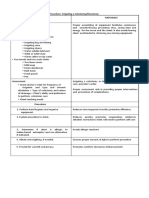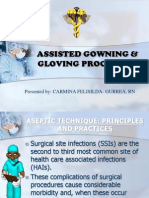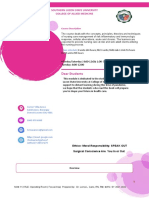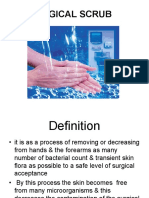Principles of Sterile Technique
Principles of Sterile Technique
Uploaded by
Aliah M. AngodCopyright:
Available Formats
Principles of Sterile Technique
Principles of Sterile Technique
Uploaded by
Aliah M. AngodOriginal Description:
Copyright
Available Formats
Share this document
Did you find this document useful?
Is this content inappropriate?
Copyright:
Available Formats
Principles of Sterile Technique
Principles of Sterile Technique
Uploaded by
Aliah M. AngodCopyright:
Available Formats
Principles of Sterile Technique
1. All articles used in an operation have been sterilized previously.
2. Persons who are sterile touch only sterile articles; persons who are not
sterile touchonly unsterile articles.
3. Sterile persons avoid leaning over an unsterile area; non-sterile persons
avoid reaching over a sterile field. Unsterile persons do not get closer than
12 inches from a sterile field.
4. If in doubt about the sterility of anything consider it not sterile. If a non-
sterile person brushes close consider yourself contaminated.
5. Gowns are considered sterile only from the waist to shoulder level in front
and the sleeves to 2 inches above the elbows.
1. Keep hands in sight or above waist level away from the face.
2. Arms should never be folded.
3. Articles dropped below waist level are discarded.
6. Sterile persons keep well within the sterile area and follow those rules
from passing:
1. Face to face or back to back.
2. Turn back to a non-sterile person or when passing.
3. Face a sterile area when passing the area.
4. Ask a non-sterile person to step aside rather than trying to crowd
past him.
5. Step back away from the sterile field to sneeze or cough.
6. Turn head away from sterile field to have perspiration mopped
from brow.
7. Stand back at a safe distance from the operating table when
draping the patient.
8. Members of the sterile team remain in the operating room if
waiting for the case.
9. Do not wander around the room or go out in the corridors.
7. Sterile persons keep contact with sterile areas to a minimum.
1. Do not lean on the sterile tables or on the draped patient.
2. Do not lean on the nurse’s mayo tray.
8. Non-sterile persons — when you are observing a case, please stay in the
room until the case is completed. Do not wander from room to room as
traffic in the operating room should be kept as a minimum. Patient privacy
needs to be respected.
9. Keep non-essential conversation to a minimum.
10.The circulating nurse is in charge of the room — if you have any
questions, please refer them to her, the supervisor or your instructor. Ask
circulating nurse when it is an appropriate time to ask questions so that
explanations/rationale can be given.
You might also like
- Kia Rio PDFDocument6 pagesKia Rio PDFJeni71% (7)
- QUIZ 1 - Geology 105Document10 pagesQUIZ 1 - Geology 105Danhy Nguyen100% (1)
- Attire, Surgical Scrub, Gowning and GlovingDocument23 pagesAttire, Surgical Scrub, Gowning and GlovingRumelle ReyesNo ratings yet
- Or Procedures NCM 112Document4 pagesOr Procedures NCM 112Dudil GoatNo ratings yet
- 13 Aseptic TechniqueDocument6 pages13 Aseptic TechniqueaironmaeNo ratings yet
- Everything Should Be New (If Available) To Avoid Cross ContaminationDocument31 pagesEverything Should Be New (If Available) To Avoid Cross ContaminationShamsa Afdal100% (1)
- Principles of SterilityDocument4 pagesPrinciples of SterilityMa. Jessel PabrigarNo ratings yet
- Principles of SterilityDocument4 pagesPrinciples of SterilityCris SolandNo ratings yet
- Surgical Asepsis 3 in The or - HTMDocument67 pagesSurgical Asepsis 3 in The or - HTMcatislandbigredNo ratings yet
- 13 Principles of Aseptic TechniqueDocument1 page13 Principles of Aseptic TechniqueMarie Antionette MondragonNo ratings yet
- Principles of Sterile TechniqueDocument3 pagesPrinciples of Sterile Techniquegaylenice100% (2)
- Perioperative Nursing: An OR NurseDocument27 pagesPerioperative Nursing: An OR NurseNorjana Malaatao100% (1)
- Fracture (Cast Care)Document6 pagesFracture (Cast Care)Vane UcatNo ratings yet
- Bandaging: Process of Covering A Wound and An Injured PartDocument23 pagesBandaging: Process of Covering A Wound and An Injured Partclarheena100% (1)
- Operating Room Nurses Knowledge and Practice of Sterile Technique 2167 1168.1000113Document5 pagesOperating Room Nurses Knowledge and Practice of Sterile Technique 2167 1168.1000113mlbrown8No ratings yet
- CHAPTER 4 and 5.the Calling of Health Care ProviderDocument17 pagesCHAPTER 4 and 5.the Calling of Health Care ProviderLouise Mica Lee100% (1)
- Prepared By: Anne Jillian T. Singson, RN, MN: (Assisting Clients in The Use of Assistive Ambulatory Devices)Document22 pagesPrepared By: Anne Jillian T. Singson, RN, MN: (Assisting Clients in The Use of Assistive Ambulatory Devices)Jan Federick Bantay100% (1)
- Skin Preparation FinalDocument4 pagesSkin Preparation FinalJerson EdilloNo ratings yet
- Sterile Field Using Sterile DrapeDocument2 pagesSterile Field Using Sterile DrapekatNo ratings yet
- GIT Checklist With RationaleDocument5 pagesGIT Checklist With RationaleTeal OtterNo ratings yet
- CHECKLIST - Administering Oral, Sublingual, and Buccal MedicationDocument4 pagesCHECKLIST - Administering Oral, Sublingual, and Buccal MedicationMichael100% (1)
- Calamba Doctors' College: Bachelor of Science in NursingDocument3 pagesCalamba Doctors' College: Bachelor of Science in NursingDaniel Daniel100% (1)
- Duties and Responsibilities of Scrub Nurse:: Before An OperationDocument7 pagesDuties and Responsibilities of Scrub Nurse:: Before An OperationMary Grace Relato BapialNo ratings yet
- Nephrostomy Tube Care: Roll No Anupama Thapa - 6 Asmita Awal - 7Document22 pagesNephrostomy Tube Care: Roll No Anupama Thapa - 6 Asmita Awal - 7Prajina KansakarNo ratings yet
- Level III Performance Checklist: Preparing A Sterile Field: Using A Commercially Prepared Sterile Kit/Tray PurposeDocument40 pagesLevel III Performance Checklist: Preparing A Sterile Field: Using A Commercially Prepared Sterile Kit/Tray PurposeRichmon SantosNo ratings yet
- Chapter IiDocument37 pagesChapter Iicoosa liquors100% (1)
- NGT Rle ProcedureDocument4 pagesNGT Rle ProcedureJan Jamison ZuluetaNo ratings yet
- Cappilary Blood Glucose Monitoring ChecklistDocument2 pagesCappilary Blood Glucose Monitoring ChecklistRenz Kier Lorenzo ComaNo ratings yet
- ) Administering Nasogastric Tube or Orogastric Tube FeedingDocument6 pages) Administering Nasogastric Tube or Orogastric Tube FeedingJohn Pearl FernandezNo ratings yet
- Retdem OxygenationDocument3 pagesRetdem OxygenationCharlize PareNo ratings yet
- Aseptic Technique ProcedureDocument10 pagesAseptic Technique ProcedureaksinuNo ratings yet
- Perioperative Nursing Skills and Procedure PDFDocument4 pagesPerioperative Nursing Skills and Procedure PDFRouwi DesiatcoNo ratings yet
- What Is Aseptic TechniqueDocument11 pagesWhat Is Aseptic TechniqueMarlchiel Nathan ArregladoNo ratings yet
- Duties and Responsibilities in or (SCRUB NURSE AND CIRCULATING NURSE) by JheaaDocument5 pagesDuties and Responsibilities in or (SCRUB NURSE AND CIRCULATING NURSE) by JheaaSareno PJhēaNo ratings yet
- Assisted Gowning & GlovingDocument12 pagesAssisted Gowning & GlovingCarmina GurreaNo ratings yet
- IntraoperativeDocument4 pagesIntraoperativeLynette Roldan RN100% (1)
- Suctioning Endotracheal Tube ETTDocument2 pagesSuctioning Endotracheal Tube ETTLyons SchimttNo ratings yet
- Dear Students: Southern Luzon State University College of Allied MedicineDocument28 pagesDear Students: Southern Luzon State University College of Allied MedicinePaul Gabriel CasquejoNo ratings yet
- Surgical Ward PretestDocument3 pagesSurgical Ward PretestCrystal Ann TadiamonNo ratings yet
- Gastrointestinal SystemDocument17 pagesGastrointestinal SystempreetNo ratings yet
- Buclb9nf9 - 3. SKL Checklist Assessment of HEENT With RationaleDocument8 pagesBuclb9nf9 - 3. SKL Checklist Assessment of HEENT With RationaleHecy CristoNo ratings yet
- Duties or NurseDocument10 pagesDuties or NursehailleyannNo ratings yet
- PRC Form (Minor Operation)Document1 pagePRC Form (Minor Operation)mawelNo ratings yet
- Handwashing MabatidDocument2 pagesHandwashing Mabatidako at ang exoNo ratings yet
- Nebulization 1Document3 pagesNebulization 1Shane Aileen AngelesNo ratings yet
- Responsibility and Role of Scrub NurseDocument2 pagesResponsibility and Role of Scrub NurseFil Aquino100% (2)
- IV Injections and InfusionsDocument2 pagesIV Injections and InfusionsFrancis Lawrence AlexanderNo ratings yet
- Performing Closed Gloving Concept: Sterile Gloves Are An Additional Barrier To Bacterial Transfer. Sterile GlovesDocument2 pagesPerforming Closed Gloving Concept: Sterile Gloves Are An Additional Barrier To Bacterial Transfer. Sterile GlovesJIESEL ACEBEDONo ratings yet
- Surgical Scrub ProcessDocument23 pagesSurgical Scrub ProcessSHALVI SHARMANo ratings yet
- Providing Steam InhalationDocument3 pagesProviding Steam InhalationMyrvic Ortiz La OrdenNo ratings yet
- Surgical Scrubs ProcedureDocument19 pagesSurgical Scrubs ProcedureBlaze GroNo ratings yet
- Nursing Care of Post Anesthesia Patients OutlinedDocument13 pagesNursing Care of Post Anesthesia Patients OutlinedRhea JessicaNo ratings yet
- Lecture Aid: Mental Health and Psychiatric Nursing 1: Lester R. L. LintaoDocument14 pagesLecture Aid: Mental Health and Psychiatric Nursing 1: Lester R. L. LintaoEsarpy (Nana)No ratings yet
- PeriopConcepts RosalesDocument43 pagesPeriopConcepts RosalesitsmekringNo ratings yet
- Question 5 Nursing ResponsibilitiesDocument6 pagesQuestion 5 Nursing ResponsibilitiesMichaela JapsayNo ratings yet
- Donning and Removing Personal Protective EquipmentDocument31 pagesDonning and Removing Personal Protective EquipmentSienna JuradoNo ratings yet
- Closed GlovingDocument2 pagesClosed GlovingMary Ann SacramentoNo ratings yet
- Assisting IV BTDocument89 pagesAssisting IV BTmhelshy villanuevaNo ratings yet
- Suctioning The TracheostomyDocument16 pagesSuctioning The TracheostomyJaily Mariano100% (1)
- Naso Orogastric Tube Guideline For The Care of Neonate Child or Young Person RequiringDocument12 pagesNaso Orogastric Tube Guideline For The Care of Neonate Child or Young Person RequiringmeisygraniaNo ratings yet
- The politics of hunger: Protest, poverty and policy in England, <i>c.</i> 1750–<i>c.</i> 1840From EverandThe politics of hunger: Protest, poverty and policy in England, <i>c.</i> 1750–<i>c.</i> 1840No ratings yet
- The Ride of Your Life: What I Learned about God, Love, and Adventure by Teaching My Son to Ride a BikeFrom EverandThe Ride of Your Life: What I Learned about God, Love, and Adventure by Teaching My Son to Ride a BikeRating: 4.5 out of 5 stars4.5/5 (2)
- MPC Instrument Collection Installation GuideDocument23 pagesMPC Instrument Collection Installation GuidePeter Andrew CallenNo ratings yet
- EIA Oxidation Pond JUDocument71 pagesEIA Oxidation Pond JUnot now100% (1)
- Dr. Med. Sylvia Grotjohann-Ernst, General Practitioner in BerlinDocument1 pageDr. Med. Sylvia Grotjohann-Ernst, General Practitioner in BerlinAkash GuptaNo ratings yet
- BD Product PresentationDocument28 pagesBD Product PresentationbudiNo ratings yet
- Operation: Mechanical Operation Operating ConditionsDocument7 pagesOperation: Mechanical Operation Operating Conditionshybrid_motorsports_llcNo ratings yet
- CBTS Hardware ManualDocument254 pagesCBTS Hardware ManualMo Ibra100% (1)
- Empr DMPR CatalogueDocument44 pagesEmpr DMPR CatalogueECATOnlineNo ratings yet
- FMDS0156-Phòng S CHDocument25 pagesFMDS0156-Phòng S CHhải vũ ngọcNo ratings yet
- 1097 8656 2 RVDocument14 pages1097 8656 2 RVAnita NMNo ratings yet
- Listings and Diagrams of Outcomes: Learner's Module in Mathematics 6Document12 pagesListings and Diagrams of Outcomes: Learner's Module in Mathematics 6Sab Gumilao Ganotice100% (1)
- N2Xfgby 2 X (1.5-300) MM 0.6/1 KVDocument4 pagesN2Xfgby 2 X (1.5-300) MM 0.6/1 KVRince OktavianaNo ratings yet
- The Essentials of Chilled Beams - Part 3: Skills WorkshopDocument3 pagesThe Essentials of Chilled Beams - Part 3: Skills WorkshoprkibNo ratings yet
- Calbank 2019 Annual ReportDocument134 pagesCalbank 2019 Annual ReportFuaad DodooNo ratings yet
- Lesson 2 The Concept of Logic CircuitsDocument23 pagesLesson 2 The Concept of Logic CircuitsAsh LeyNo ratings yet
- Climate ChangeDocument124 pagesClimate ChangeNewdeersciNo ratings yet
- html5 css3 Session9Document44 pageshtml5 css3 Session9Samuel BellamyNo ratings yet
- IB HL Physics IADocument13 pagesIB HL Physics IAisha ramanNo ratings yet
- Books From The Troth: Idunna. We Aim To Be A Resource For All Who Would Learn More About Our WaysDocument7 pagesBooks From The Troth: Idunna. We Aim To Be A Resource For All Who Would Learn More About Our WaysAang SifNo ratings yet
- Gaussian BeamsDocument58 pagesGaussian BeamsDaniel Humberto Martinez SNo ratings yet
- Effect of Rocks Anisotropy On Deviation Tendencies of Drilling SystemsDocument4 pagesEffect of Rocks Anisotropy On Deviation Tendencies of Drilling SystemsMejbahul SarkerNo ratings yet
- A Multi-Method Approach To Korean Speakers' Acquisition of Unaccusativity in EnglishDocument52 pagesA Multi-Method Approach To Korean Speakers' Acquisition of Unaccusativity in Englishstoryminer1No ratings yet
- A114 - 24th Floor Plan As RevisedDocument1 pageA114 - 24th Floor Plan As RevisedAnas RVNo ratings yet
- 101 Excel FunctionsDocument33 pages101 Excel Functionssehrishb01No ratings yet
- Aisling McCluskey, Brian McMaster - Undergraduate Analysis - A Working Textbook-Oxford University Press (2018)Document398 pagesAisling McCluskey, Brian McMaster - Undergraduate Analysis - A Working Textbook-Oxford University Press (2018)currecurreNo ratings yet
- May 9Document10 pagesMay 9rossana rondaNo ratings yet
- Mental Concentration Test PDFDocument1 pageMental Concentration Test PDFKashif Raheem NoonariNo ratings yet
- Bachelor Thesis MediationDocument6 pagesBachelor Thesis Mediationconnierippsiouxfalls100% (2)
- CoSt AcCOunting Project RePOrtDocument28 pagesCoSt AcCOunting Project RePOrtsabeen ansari0% (1)

























































































